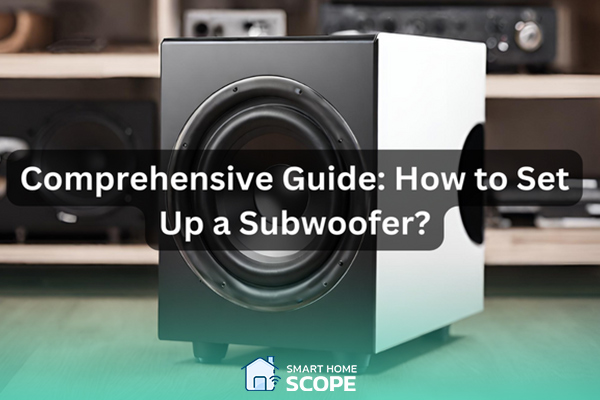A subwoofer setup is an important part of any home audio experience, as it can greatly impact the sound quality. It is crucial to learn how to set up a subwoofer or else you’ll end up with just boosted bass which is not the purpose in a subwoofer setup! I am Erfan Askari, a home theater and smart home enthusiast, and in this article, I’ll share my experience with you on achieving impactful bass with your subwoofer device!
What Are the Steps in Creating a Subwoofer Setup?
When you try to set up a home theater, setting up a subwoofer is one of the main steps; below are the steps you have to take. We will cover each one thoroughly moving forward:
- Understanding subwoofers
- Preparation for subwoofer setup
- Connecting your subwoofer
- Optimal placement of the subwoofer
- Calibrating your subwoofer
- Fine-tuning for best subwoofer setup performance
- Advanced tips and tricks
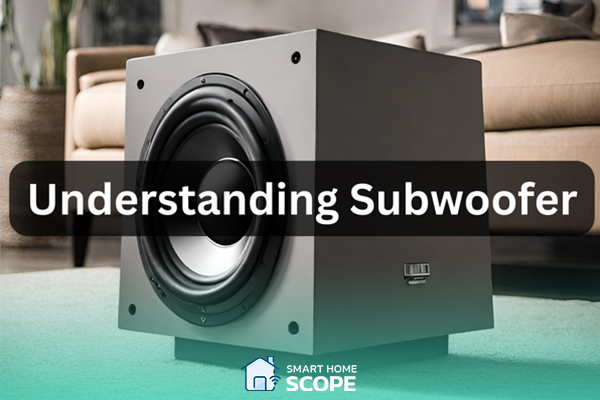
Subwoofer Setup: The First Step Is Understanding Subwoofers
A subwoofer goes beyond being a speaker; it plays a role, in enhancing the authenticity and richness of your audio encounters. Setting it up properly requires an understanding of its sorts and purpose. What you should know is broken down as follows:
Subwoofer Types
- Passive Subwoofers: These speakers need a separate amplifier. They provide versatility in terms of amp selection, but the power output of the amplifier must be carefully matched.
- Powered (Active) Subwoofers: Integrated amplifiers. The fact that they are made specially to function with the subwoofer driver makes them straightforward to set up.
- Wireless Subwoofers: They still need a power source, but they are easier to install and don’t need running cables.
Role in an Audio System
Low-frequency sounds, or bass, are handled by subwoofers and are essential for a rich, immersive audio experience. They give gaming audio more realism, movie soundtracks more power, and music more depth.
A well-integrated subwoofer should fill in the bass frequencies without standing out about your main speakers.
Advanced Features
A few subwoofers include capabilities like phase control, adjustable crossover settings, and room correction. These features can considerably increase the subwoofer’s performance in your specific environment.
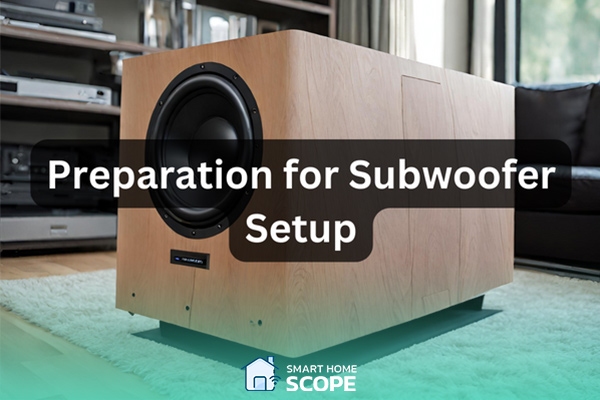
Preparation for Subwoofer Setup
Your subwoofer has to be set up long before you plug it in. Making sure your subwoofer fits into your room and produces the greatest sound possible requires careful planning. This is how to begin.
Gathering Essential Tools and Materials
Make sure you have all the tools you’ll need before you start. This contains any special cords needed for your model (e.g., optical cables for digital setups or RCA cables for analog connections), a level to make sure your subwoofer is positioned appropriately, and a tape measure for spacing.
Having some simple tools, such as a screwdriver, is also a good idea in case you need to alter any stands or supports for your subwoofer.
Room Analysis to Set Up Subwoofer
The way sound waves travel and interact in your space is greatly influenced by their size and form. To estimate the size of your space, use a tape measure. Take note of any big furniture pieces as they may have an impact on how sound is distributed.
Take note of the flooring’s composition. Carpets tend to absorb sound, but hard surfaces like wood or tile might reflect it. You’ll find this information useful later on when arranging the subwoofer.
Identifying Potential Subwoofer Locations
Determine a couple of possible locations for your subwoofer to start. Typical spots are next to the front speakers, along a wall, or in corners. Every location will have a unique acoustic interaction with your space.
Recall that the objective is to locate the subwoofer such that it enhances the sound of your current speakers and provides the room with deep, well-balanced bass.
Dealing with Room Acoustics
The acoustics of your room may have a big impact on the sound you hear. Consider adding some soft furniture or acoustic panels to absorb extra sound if your space is particularly echoey.
Try other arrangements with these components. Sound waves in a room can occasionally be noticeably altered by shifting a couch or drawing a heavy curtain.
Safety and Precautions
The priority should always be safety. Make sure that there are no wire-tripping hazards where the subwoofer is located.
Take the subwoofer’s weight into account as well. If it’s going to be on a shelf or other elevated surface, ensure sure it can hold the weight without collapsing.
You’re establishing the foundation for a subwoofer setup that not only sounds fantastic but also blends in perfectly with your living space by taking the time to properly prepare your area.

How to Set up Subwoofer: Connecting Your Subwoofer
Connecting your subwoofer to your music system is the next step after setting up your area. Depending on the subwoofer type and the system you’re integrating it with, this procedure may change. Here is a thorough how-to guide to get you through this phase:
Understanding Connection Types
Determine the kind of connections that your subwoofer can handle. Speaker-level inputs (for stereo systems without a dedicated subwoofer output), RCA (for the majority of home theater systems), and digital inputs like optical or coaxial are common types.
Make sure the wires you have fit the kind of connection on your device. An RCA cable is usually used for analog connections, while a digital audio cable is required for digital connections.
Also Read:
How to Pair Vizio Subwoofer Without Soundbar?
Connecting to a Home Theater System
The ‘Sub Out’ or ‘LFE’ (Low-Frequency Effects) port on a home theater receiver with a dedicated subwoofer output should be connected to the ‘Line In’ on the subwoofer using an RCA wire.
You can connect each subwoofer to its output if your receiver offers multiple subwoofer outputs and you possess more than one subwoofer.
Connecting to a Stereo System
If your audio system lacks a dedicated subwoofer output, speaker-level connections will need to be used. Attach speaker cables to the high-level inputs on the subwoofer from the speaker outputs of the amplifier.
Connect your speakers to the high-level outputs of the subwoofer. This enables the subwoofer to filter out low frequencies in concert with your speakers.
Digital Connections
Connect the digital audio wire from your receiver’s digital out to your subwoofer’s digital input if your system has digital outputs. The majority of the time, digital connections are simple to use and offer excellent audio transmission.
Troubleshooting Common Issues
If you hear a buzzing or humming, there can be a grounding problem. Make sure that every component is plugged into the same socket or power strip. Verify the stiffness of each connection and make sure the wires are in good condition.
Final Checks
Play some audio as a fast test after everything is linked. To make sure your subwoofer complements your speakers, turn down the volume. Try using the phase control function on your subwoofer to see if it enhances the integration with your main speakers.
You should be able to connect your subwoofer to your audio system and enjoy better sound quality in your entertainment setup by following these procedures.
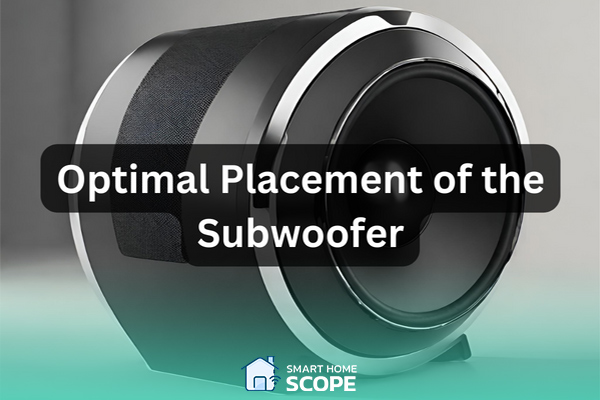
Optimal Placement of the Subwoofer
To attain pinnacle sound quality, the precise placement of your subwoofer setup is imperative. Your auditory voyage is significantly influenced by its location, as it fundamentally transforms the interplay of bass frequencies in the space. Here’s how to decide where your subwoofer should go:
Understanding Room Acoustics
The acoustics of each room are different. There might be peaks and nulls in the sound as a result of sound waves reflecting off of ceilings, floors, and walls.
The subwoofer should be positioned to reduce these acoustic problems and provide a more uniform bass response across the space.
The Subwoofer Crawl Test
A useful technique for determining the ideal location is the subwoofer crawl test. Put the subwoofer in your favorite listening position, turn on some bass-heavy music, and move slowly about the room.
Your subwoofer might be placed in the places where the bass is the loudest and most consistent.
Corner Placement
The subwoofer’s output may frequently be increased by placing it in a corner, which amplifies the bass. However, depending on the acoustics of the environment, this might occasionally result in boomy or muddy bass.
Play around with where the corners are placed, but be ready to make adjustments if the bass is overemphasized.
Avoiding Symmetry
Aim to keep the subwoofer away from two parallel walls at equal distances. This symmetrical configuration may exacerbate standing wave difficulties, resulting in an uneven bass response.
Having the placement asymmetrical can frequently result in a more evenly distributed bass across the space.
Dealing with Multiple Subwoofers
It becomes much more important to locate your subwoofers if you have many units. The intention is for them to cooperate to mitigate the bass response.
A more even distribution of bass can be attained by positioning them at various distances from one another or at opposing corners of the same wall.
Final Adjustments
After you’ve located a possible location, adjust the subwoofer’s positioning by moving it a few inches at a time. Minor modifications can have a big impact.
To make sure the bass sounds nice across the room, not just at the sweet spot, try listening from various angles.
Through careful positioning of your subwoofer and the use of these strategies, you may dramatically improve the overall quality of sound produced by your audio system.
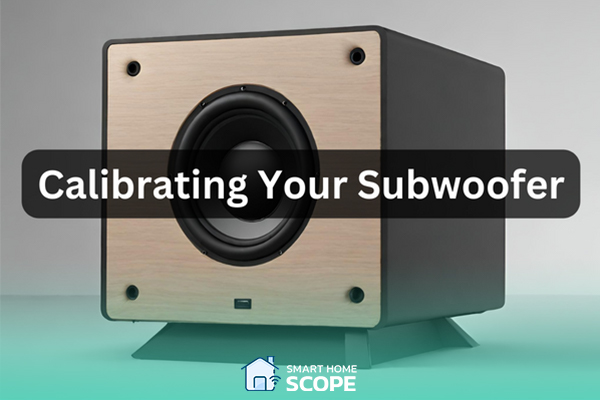
Subwoofer Setup: Calibrating Your Subwoofer
The next important step is to calibrate your subwoofer after attaching and positioning it. A properly calibrated subwoofer will produce the greatest sound possible by blending in with your environment and other speakers. Here’s how to properly adjust your subwoofer:
Setting the Crossover Frequency
The crossover frequency establishes the threshold at which the bass frequencies from your primary speakers are transferred to your subwoofer. Although 80 Hz is a typical beginning point, this might change depending on the capability of your speakers.
Smaller primary speakers may have trouble handling lower frequencies, which means a greater crossover point is required. On the other side, a lower crossover setting is possible with larger speakers since they can withstand lower frequencies.
Adjusting Subwoofer Volume
Lower the subwoofer’s volume setting to begin. Play a song with a steady bass line and turn up the volume little by bit until your main speakers and subwoofer are in perfect harmony.
The low frequencies in the space should be organically filled in by the subwoofer, without becoming overpowering.
Phase Alignment
To coordinate the bass sound from the subwoofer with the main speakers, the phase control modifies its time.
Play a song with lots of bass and play about with the phase control options. When the bass is fully blended with your speakers and sounds the richest, you are in the correct setting.
Using Room Correction Software
Use the built-in room correction software on your subwoofer or receiver to automatically change settings for the best performance in your particular space.
These systems automatically alter the subwoofer settings based on an analysis of the room’s acoustics using a microphone.
Manual Listening Tests
Have faith in your hearing. Sit in your typical listening posture and listen to a variety of recordings after making modifications based on measurements and software.
Depending on what you hear best in your listening situation, make small modifications to the crossover and volume settings.
Subwoofer Setup: Consistency Across Different Listening Positions
Examine the room’s bass response in various locations. Ideally, the bass should sound well in other seating places as well, even if the main attention is on your primary listening position.
Although it may take some trial and error, calibrating your subwoofer is worthwhile. A well-calibrated subwoofer will improve your listening experience and match your audio system.

Fine-Tuning for Best Performance
To get the most performance out of your system, fine-tuning is necessary once you’ve calibrated your subwoofer. To improve the overall sound quality, this procedure entails applying particular techniques and making little modifications. Here’s how to adjust your subwoofer precisely:
Using Measurement Tools
To get a visual depiction of your subwoofer’s performance in the room, use sound measuring equipment such as a room analysis app or a sound level mete
Examine the frequency response for any peaks or dips, and then modify the subwoofer’s location or settings to even them out.
Listening Tests with Varied Content
To evaluate the subwoofer’s performance from various audio sources, play a range of content, such as games, movies, and music.
Keep an eye on the subwoofer’s response to various bass frequencies. If you find that some stuff doesn’t sound as nice, change the settings.
Balancing with main Speakers
Make sure your primary speakers are not being overpowered by the subwoofer. The aim is to accomplish a smooth integration in which the subwoofer enhances the speakers without taking center stage. If needed, adjust the crossover and volume levels to keep this balance.
Room Acoustic Adjustments
If there are too many or too few bass frequencies in your space, you might want to adjust the acoustics. The sound can be balanced by moving or adding rugs, acoustic panels, or furniture.
Try arranging these things differently to observe how the subwoofer performs.
Regular Re-evaluation
Your tastes or the conditions of the space may alter with time. Review your subwoofer’s settings from time to time and make any necessary modifications.
This guarantees that your subwoofer will constantly operate at peak efficiency, adjusting to modifications in your setup or surroundings.
Your subwoofer has to be fine-tuned continuously, which takes time and careful attention to detail. Regularly evaluating and modifying your setup will allow you to have the best possible audio experience, according to your tastes and the features of your environment.
Advanced Tips and Tricks
If you want to get more engaged with subwoofer setup and optimization, there are various advanced approaches that can boost sound quality even more.
These ideas are quite valuable for people who enjoy music and wish to improve the performance of their subwoofer. What you can investigate is this:
How to Set Up Dual Subwoofer Integration
Bass in the space may be much more evenly distributed by using two subwoofers. To balance the sound, arrange them symmetrically across the room or at opposite ends.
To make sure the subwoofers function together and don’t produce too much bass in some places, adjust each one separately. If you have a Vizio subwoofer, or any other brand, I suggest you read the guide below for dual subwoofer integration.
Also Read:
Can You Connect 2 Subwoofers to a Vizio Soundbar?
Room Mode Analysis
Analyze room modes, or certain frequencies that resonate disproportionately in a space, to learn more about room acoustics.
After identifying these modes with acoustic measuring tools, place your subwoofer or use acoustic treatments to lessen the influence of the modes.
Subwoofer Isolation
Think about utilizing isolation pads or a platform for subwoofers. These can lessen the vibrations that are transmitted to the floor, which can affect the acoustics of the space and change the sound’s color.
A tighter, cleaner bass sound can result from isolation, particularly in apartments or rooms with hardwood flooring.
Experimenting with Phase and Delay Settings
If your equipment permits it, play around with more accurate delay settings in addition to the standard phase adjustment. By doing this, you may better coordinate the output of the subwoofer with your primary speakers.
This is especially helpful in intricate arrangements or spaces with odd shapes.
Custom EQ and DSP Settings
Use the digital signal processing (DSP) or EQ settings that may be adjusted on your subwoofer or receiver to optimize the sound.
To adapt the output to the features of your environment, adjust the EQ to make up for any recurring peaks or dips in the bass response.
Regular Firmware Updates
Ensure that the firmware for your subwoofer setup, particularly those boasting digital features, remains meticulously updated. Manufacturers routinely release updates imbued with fresh functionalities or performance refinements
Investigating these cutting-edge techniques will allow you to greatly improve the performance of your subwoofer and meet the demands of even the most discerning audiophiles.
Subwoofer Setup: Maintenance and Care
It is important to provide regular maintenance and appropriate care for your subwoofer to guarantee its optimal performance over time. How to maintain the best possible condition for your subwoofer:
Routine Cleaning
The accumulation of dust and dirt on your subwoofer may hurt its functionality. Use a gentle, dry cloth to dust the outside regularly.
Steer clear of utilizing abrasive or harsh chemicals as they may harm the components or finish.
Checking Connections
Verify all connections regularly to make sure they are tight and free of corrosion or damage. Intermittent audio problems or low sound quality might be caused by loose connections.
To preserve the best possible sound quality, replace cables as soon as they begin to exhibit wear or damage.
Avoiding Overheating
Make sure your subwoofer has enough airflow to avoid overheating, particularly if it’s positioned in a confined area like a cabinet.
The subwoofer’s lifespan and performance might be reduced by overheating.
Managing Volume Levels
Although it may be tempting to overload your subwoofer, doing so over time might cause damage to the device from continuous excessive volume playback.
To extend the life of the subwoofer, listen at moderate volumes and refrain from using it at full volume for extended periods.
Firmware Updates
Make sure the firmware for subwoofers with digital features is up to date. This can be used to fix bugs and improve functionality while also ensuring top performance.
Professional Servicing
Think about getting expert service if you discover any problems with performance or sound quality that you are unable to fix.
Frequent expert inspections can help preserve the subwoofer’s functionality and spot possible faults before they get out of hand.
Your subwoofer will continue to provide you with excellent bass for many years to come if you adhere to our maintenance and care recommendations.
Conclusion
Achieving the best subwoofer setup requires a combination of technical expertise and artistic vision. Every stage, from appropriate placement to maintenance is crucial to use the full potential of your subwoofer setup. I hope now that you know how to set up a subwoofer, you have a good audio experience with it!
FAQs
What is a good way to tell whether my subwoofer is too loud?
The bass may be overly strong if it drowns out other frequencies or vibrates the entire space, making the music less clear. Try to strike a balance such that the bass enhances the whole sound rather than taking center stage.
Does the location of a subwoofer affect the sound quality?
Without a doubt. The way bass frequencies interact with your home can be greatly influenced by the location of your subwoofer. Finding the sweet spot for the optimum sound may be accomplished by experimenting with different settings.
In a tiny room, is a subwoofer appropriate?
A subwoofer may be used in a small room, but it’s important to tune the crossover and volume levels properly to prevent the bass from overpowering the area.




